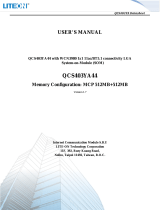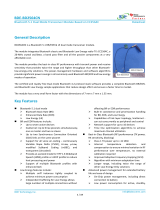VESTEL 17BT02 Bluetooth module Manuel utilisateur
- Taper
- Manuel utilisateur

1
17BT02
Product Specification
and User Manual
1. General Description
The 17BT02 is used in Linux based platforms, it is working as a daughter board for connecting
wireless sound devices and HID devices. It supports one connector to attach main boards. The
socket uses USB signal interface at 5V supply voltage. Bluetooth module with Bluetooth 4.2
Modulations: GFSK, π/4 DQPSK, 8DPSK are used. Bluetooth Low Energy functionality disabled
by firmware.
2. Features
BT4.2 compliant
A2DP source and HID profiles
Printed PCB antenna
USB interface
20Mhz Crystal
3. Key Specifications
Main chipset
CYW20705B, Cypress
Frequency range
2402-2480 MHz
Channels
0-78
Host interface
USB

2
4. Electrical Specifications
4.1. Power supply voltages
DC supply to module
Min
Typ
Max
VCC
4.75 V
5 V
5.25 V
5. RF Characteristic
5.1. Antenna Gain
2.4 Ghz
Antenna 0
0.84 dBi
5.2. TX/RX Characteristic
17BT02
Channel
DH1
3DH5
Tx Power
(dBm)
Rx Sensitivity
(dBm)
Tx Power
(dBm)
Rx Sensitivity
(dBm)
Ch_0
6,4
-88,5
6,26
-87,5
Ch_39
6,64
-88,5
6,55
-88
Ch_78
6,55
-88
6,48
-84
6. Mechanical Characteristics
- Module dimension 40x17mm.

3
7. Pin Description
Pin No.
Pin Name
I/O
Pin Description
1
3D_sync
I
Panel 3D sync signal 50/60 Hz
2
VCC
I
VCC 5V
3
USB_DP
I/O
USB Communication Signal
4
USB_DN
I/O
USB Communication Signal
5
GND
-
Ground
8. Environmental
8.1. Operating
Operating Temperature: 0 to 65 °C
8.2. Storage
Temperature: -20 to 85 °C
9. Device Installation
The module is a build in module. It will be used in-house production as an embedded device
over USB 2.0 interface and there is no need any interaction with end-user. Positioning of the module is
defined by assembly operator instructions for each product by Vestel. The module should be mounted
by considering operating temperature. The temperature of the installation location should be between
0°C and 65 °C.
The module can be integrated in any moblie/fixed host device. For portable devices a minimum
seperation distance of 10 mm between the antenna and the human body shall be observed to aviod
SAR requirements. The implementation of the module in a specific end-product should also be reviewed
to ensure compliance with the FCC and IC requirements for SAR and MPE.
The host integrator must follow the integration instructions provided by Vestel and ensure that
the composite-system end product complies with the FCC requirements by a technical assessment or
evaluation to the FCC rules and to KDB Publication 996369.
Installed module’s FCC ID and IC numbers need to be clearly marked on the product with the
following verbiage “Contains FCC ID: 2AVQS-17BT02” and “Contains IC: 25888-17BT02”.
Host label shows the FCC and ISED identifier of the module. FCC and ISED identifier will be
visible on the back cover of the host device. Also, the modular transmitter meet only FCC and ISED
authorized for the specific ruleparts, and the host must show complains with his own rule parts.
The module has been tested and approved as a Modular Radio in accordance with the
appropriate FCC and IC standards. The supporting test data may be found in the modular test report.
Since this module has been certified as a Modular Radio, this allows the end user to integrate
this module into an end-product without the requirement of re-certifying the radio module. The
module-integrator is responsible for the unintentional conducted and radiated emissions and must
verify that the integrated product is compliant with the rules associated with unintentional radiators.
The module integrator is also required to maintain an engineering record of the verification testing and
declare on the product through proper labeling and marking that the device is compliant with these particular
rules. Although already certified, radio tests according to KDB996369 clause 3.4 have to be carried out also.
This device complies with part 15 of the FCC Rules and ISED licence-exempt RSS(s).
Operation is subject to the following two conditions:
This device may not cause harmful interference, and this device must accept any
interference received, including interference that may cause undesired operation.

4
Changes or modifications not expressly approved by the party responsible for compliance
could void the user’s authority to operate the equipment. Antenna connector port is not for use and
disconnected at market products. Module is only allowed to use with the on board printed antenna.
Vestel provides user notices in both English and French when the product is made available
for sale and/or lease in Canada.
This device contains licence-exempt transmitter(s)/receiver(s) that
comply with Innovation, Science and Economic Development Canada’s licence-exempt RSS(s).
Operation is subject to the following two conditions:
1. This device may not cause interference.
2. This device must accept any interference, including interference that may cause undesired
operation of the device
L'émetteur/récepteur exempt de licence contenu dans le présent appareil est conforme aux
CNR d'Innovation, Sciences et Développement économique Canada applicables aux appareils
radio exempts de licence. L'exploitation est autorisée aux deux conditions suivantes :
1. L'appareil ne doit pas produire de brouillage;
2. L'appareil doit accepter tout brouillage radioélectrique subi, même si le brouillage est
susceptible d'en compromettre le fonctionnement.
Software Installation
The SW driver is already installed to host device software platform which is a Linux/Android OS.
-
 1
1
-
 2
2
-
 3
3
-
 4
4
VESTEL 17BT02 Bluetooth module Manuel utilisateur
- Taper
- Manuel utilisateur
dans d''autres langues
Documents connexes
Autres documents
-
 LITE ON QCS403YA Manuel utilisateur
LITE ON QCS403YA Manuel utilisateur
-
 BDE BD2564CN Bluetooth 5.1 Dual Mode Transceiver Module Based on CC2564C Manuel utilisateur
BDE BD2564CN Bluetooth 5.1 Dual Mode Transceiver Module Based on CC2564C Manuel utilisateur
-
LG MB3021 Bluetooth 5.1 Smart Device Module Manuel utilisateur
-
Lantronix Open-Q Mode d'emploi
-
GSD WXT2F Manuel utilisateur
-
DOODLe labs ACM-DB-2M Mode d'emploi
-
Telit Wireless Solutions LN940 WWAN M.2 Manuel utilisateur
-
Intermec IM11 Integration Manual
-
Mediatek MT7922A22M Mode d'emploi





